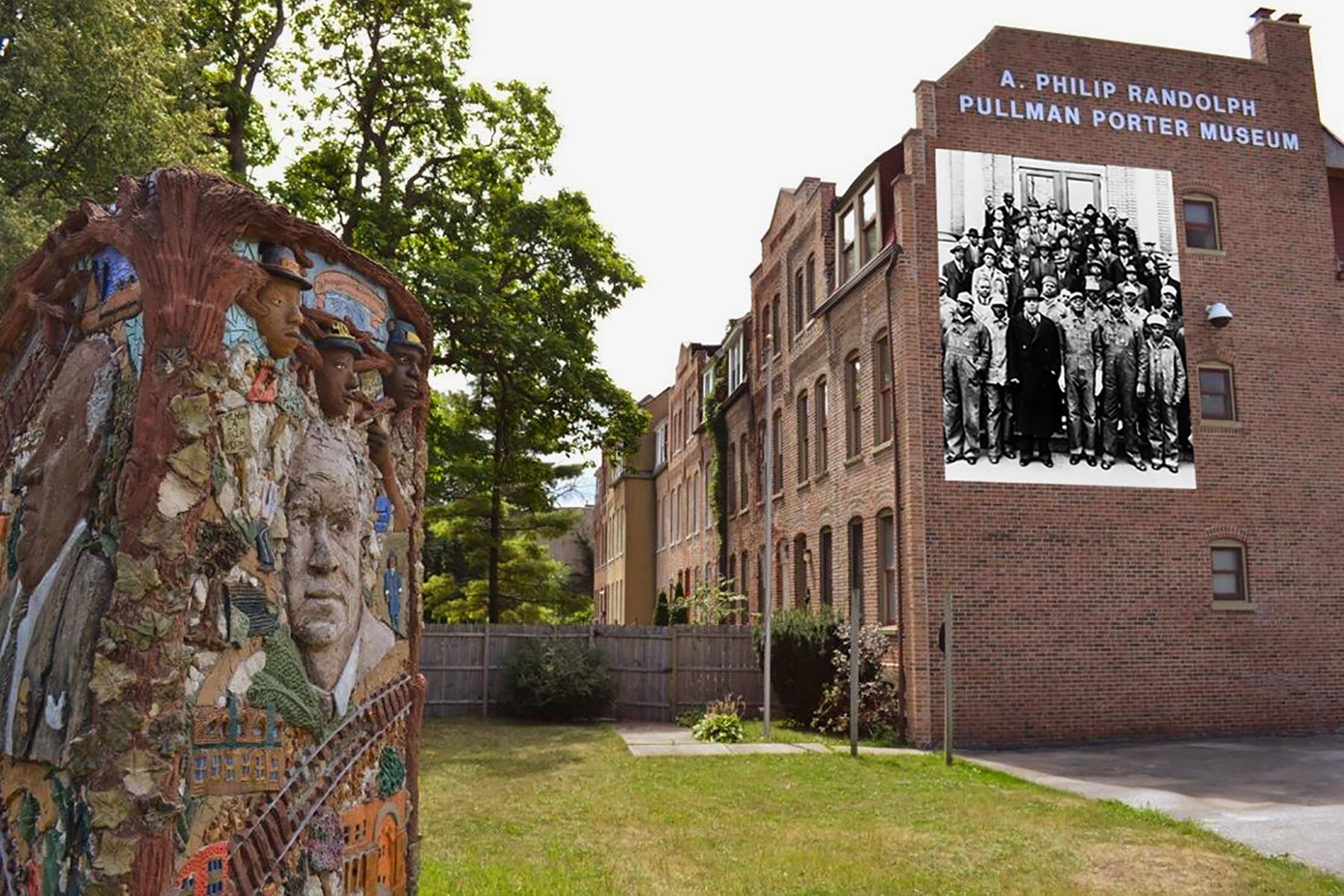Just south of Chicago, the Pullman National Monument and the A. Philip Randolph Pullman Porter Museum tell the story of one of the first major victories for civil rights.
On February 19, 2015, President Barack Obama designated national monument status to the Pullman Historic District, making it the first national park service in Chicago. Far from incidental, the designation acknowledges America’s first company-created community and honors the role of all Pullman rail employees in America’s labor movement.
But it is the Pullman Porters that beckon history’s spotlight. Still working over 20 hours a day for the worst pay after initial labor reform, the African American porters were excluded by workers’ unions. Recognizing their dignity and collective power, they traveled from Chicago to Harlem to meet with a magazine publisher and labor activist. What happened next established a path for an entire movement.
The Brotherhood of Sleeping Car Porters
For a century, the porters of Pullman’s Palace Cars traveled the country by rail. Pullman initially recruited newly-freed slaves from the south to provide “elite service” as attendants and cooks. As part of the emerging African American middle class, they were symbols of economic stability and opportunities for Black families. They also served as a crucial pipeline of information on jobs and housing for Black communities across America living under Jim Crow segregation laws.
Recommended Fodor’s Video
And while their ranks would eventually include Thurgood Marshall and Malcolm X, they too were under the thumb of segregation. Black employees were not allowed to live in Pullman’s company town, living primarily in Chicago’s Bronzeville. And despite their contributions and importance, through 1925, they still were wildly overworked, underpaid, and frozen out of the established labor unions.
Still working over 20 hours a day for the worst pay after initial labor reform, the African American porters were excluded by workers’ unions.
After multiple attempts to start their own union, the porters turned to Asa Philip Randolph, the founder of The Messenger, a magazine written by and published for African Americans. The New York magazine publisher had written numerous pieces about the porters and labor rights. A delegation met with Randolph in Harlem in 1925 and agreed: they would stand firm and become “masters of [their] own economic fate.” The Brotherhood of Sleeping Car Porters (BSCP) was born.
The next 12 years were a battle with the Pullman company, full of job threats, firings, and harassment. But the union stood resolute and won. The BSCP became the first union of Black workers to be recognized by a major organization. And as President Obama noted at the monument’s designation in Chicago, it was pivotal.
“This was one of the first great victories in what would become the Civil Rights Movement,” President Obama said at the time. “[The union] allowed A. Philip Randolph to pressure President Roosevelt to desegregate the defense industry. It was those Pullman porters who gave the base by which A. Philip Randolph could convince President Truman to desegregate the Armed Forces. It was those porters who helped lead the Montgomery Bus Boycott, who were the central organizers of the March on Washington.”
Before Dr. Martin Luther King Jr. delivered his now-iconic speech at the March on Washington, Randolph started the day. “We are the advanced guard of a massive, moral revolution for jobs and freedom,” he said. “We here today are only the first wave.”
More Than a Museum: Inspiring Cultural Activism and Economic Development
The A. Philip Randolph Pullman Porter (APRPP) Museum, a national monument partner, shares this revolution. But not only does the museum preserve the history of the Pullman Porters, it continues their legacy of knowledge and community development. Even during a pandemic year, the APRPP Museum launched virtual tours and a traveling exhibit, hosted multiple community food giveaway and financial literacy events, started the first annual citywide Juneteenth parade, and began a community development initiative.

“Their example is proof of concept,” says APRPP Museum President David Peterson, speaking about the impact of the union. “These gentlemen and women were fighting for equity before civil rights. There are role models today that say good things, do good things, are active in philanthropy. But seldom is there a proof of concept of how you change things civically with these measurable outcomes.”
Celebrating 26 years this month, Peterson attributes the success of this small, Black cultural business to the power and struggle of those who came before him. “For all practical purposes, we should have been closed down and been completely appropriated and politically ostracized. What drives us is in us, not on us, and it creates a sense of resilience that is just not human-like. I’ve been positively charged by this story since I was a teenager, and as an adult, it’s become a life mission.”
Going forward, Peterson is optimistic about working with other Pullman partners and the national monument’s new superintendent that is bringing a wave of energy. The APRPP will continue its Museum 44 program for African American youth, urban renaissance workshops, and its collaborative work on a Community Economic Development Empowerment Project. But the museum also seeks to increase its footprint and secure sustainable funding.
“There are so many different stories we could tell if we were just two steps below other cultural institutions. We always catch ourselves scrambling. We’re entrepreneurs by spirit. We appreciate the struggle, but we would rather appreciate the innovation. You see what we were able to offer during a pandemic on a shoestring budget. Just imagine what we could do with another tenth of the budget. We would be on another stratosphere.”
Visiting the Pullman National Monument
The word “monument” can be deceiving. Those planning on pulling up to a statue are in for a surprise. In this case, the Pullman National Monument actually captures most of the historic district, 250 acres of the original Pullman community. The area not only preserves architecture and history but is also home to ordinary citizens living everyday lives in those Queen Anne-style rowhomes.

Start at the Visitor Information Center for displays, volunteer support, and an introductory film on the groundbreaking neighborhood. Whether the center is closed or not, you can grab a self-guided tour map just outside of the door and hit the streets in this intentionally walkable and contained community.
In the north of the district, visitors can further explore the inspiring stories from the Brotherhood of Sleeping Car Porters at the A. Philip Randolph Pullman Porter Museum. Architectural fans will enjoy the Hotel Florence, Market Hall, and the Greenstone United Methodist Church in the southern section and the homes throughout.
Taking the narrative outside of the monument, travelers can also visit Bronzeville. Historically known as Chicago’s “Black Metropolis” after the Great Migration north, this South Side neighborhood was home for many Pullman Porters and their families. Modern Bronzeville has undergone a revitalization and remains a hub of African American culinary, artistic, and cultural endeavors. The Obama Presidential Center will reinforce the renaissance when it breaks ground in nearby Jackson Park this year.




